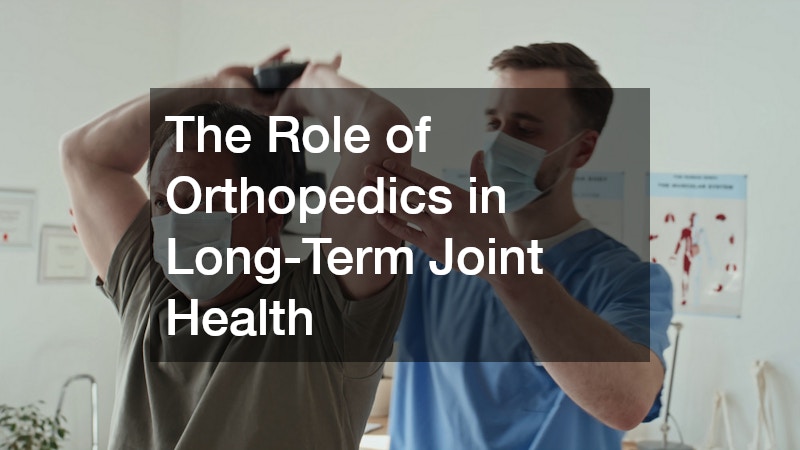Orthopedics plays a crucial role in maintaining long-term joint health. This article explores how orthopedic interventions, preventive measures, and advancements in medical technology contribute to joint health and overall quality of life. By understanding the impact of these elements, individuals can take proactive steps towards ensuring their long-term joint wellness.
How Orthopedic Surgery Improves Joint Health
Types of Orthopedic Surgeries
Orthopedic surgeries such as joint replacements, arthroscopy, and other corrective procedures are designed to address various joint issues. Joint replacements, like knee and hip replacements, are particularly effective in relieving pain and restoring mobility in patients with severe joint damage. Arthroscopic surgery offers a minimally invasive option to diagnose and treat joint problems, often resulting in quicker recovery times and less postoperative discomfort.
The introduction of minimally invasive techniques has revolutionized orthopedic surgery, allowing for smaller incisions and less tissue damage. These advancements have led to shorter hospital stays and quicker return to daily activities for many patients. Moreover, corrective surgeries that realign bones and joints can significantly improve joint function and prevent further deterioration.
Patients undergoing these surgeries often experience significant pain relief and improved joint stability. The procedures help in reducing inflammation and preventing further damage, thus contributing to long-term joint health. It is essential for patients to discuss all available options with their orthopedic surgeon to determine the best course of action for their specific conditions.
Recovery and Rehabilitation
Recovery and rehabilitation are critical components of successful orthopedic surgery outcomes. Engaging in a structured rehabilitation program can help patients regain strength, flexibility, and range of motion in the affected joints. This process not only aids in the healing process but also prevents complications such as stiffness or atrophy.
Physical therapy is often a cornerstone of rehabilitation, with therapists guiding patients through exercises that promote healing and restore function. Consistent follow-up appointments with healthcare providers ensure that the recovery is on track and adjust therapy plans as needed. Effective rehabilitation can significantly enhance the longevity and success of orthopedic procedures.
Moreover, patient education on lifestyle modifications and self-care practices is vital for sustaining joint health post-surgery. Understanding the importance of rest, balanced activity, and adherence to therapy regimens can make a significant difference in recovery outcomes. By taking an active role in their recovery, patients can achieve better results and enjoy long-term improvements in joint health.
Preventive Measures That Support Joint Health
Diet and Nutrition
A balanced diet rich in nutrients is fundamental to maintaining healthy joints and preventing degeneration. Foods high in omega-3 fatty acids, such as salmon and walnuts, can reduce inflammation and promote joint lubrication. Calcium and vitamin D are also crucial for maintaining bone density and joint function, with dairy products, leafy greens, and fortified foods being excellent sources.
Incorporating a variety of fruits and vegetables ensures that the body receives necessary vitamins like C and E, which have antioxidant properties beneficial for joint health. Whole grains are another essential component of a joint-friendly diet, providing necessary fiber and other nutrients. Avoiding excessive consumption of processed foods and sugars can help reduce the risk of inflammation-related joint problems.
Exercise and Physical Activity
Regular exercise is crucial for maintaining joint health, as it strengthens muscles that support joints and enhances flexibility. Weight-bearing exercises, such as walking and resistance training, can also help maintain and improve bone density. Flexibility exercises, such as yoga or pilates, improve range of motion, allowing joints to move more freely and without pain.
Low-impact aerobic activities like swimming or cycling are particularly beneficial for individuals with existing joint concerns, as they provide cardiovascular benefits without putting undue stress on the joints. Implementing a well-rounded exercise program tailored to one’s capabilities and needs can prevent injuries and improve overall joint function. Consulting with a physical therapist or fitness expert can assist in creating a safe and effective exercise routine.
The Latest Innovations in Orthopedics
Technological Advancements
Recent technological advancements in orthopedics have led to more precise and effective surgical interventions. Robotics-assisted surgeries offer high precision, leading to improved alignment and longer-lasting joint replacements. Minimally invasive techniques using advanced imaging allow surgeons to perform complex procedures with smaller incisions, reducing pain and recovery time.
Custom prosthetics, tailored to an individual’s anatomy through 3D printing, ensure a better fit and function, enhancing patient outcomes. These innovations not only improve the surgical process but also deliver superior long-term results in terms of mobility and pain reduction. With continuous research and development, the scope of possibilities in orthopedic surgery continues to expand.
Research and Development
Ongoing research in the field of orthopedics is uncovering new methods to enhance joint health and surgical outcomes. Clinical trials exploring the efficacy of novel therapies and interventions continuously contribute to the evolution of orthopedic medicine. The integration of artificial intelligence in analyzing patient data is paving the way for personalized treatments and more accurate diagnoses.
Innovative developments are also being made in the materials used for implants and prosthetics, improving durability and biocompatibility. These advancements help minimize infection risks and extend the lifespan of joint replacements, reducing the need for revision surgeries. As orthopedic science continues to evolve, the potential for improving patient quality of life through advanced joint health management becomes increasingly promising.
Orthopedics is essential for sustaining long-term joint health through surgical interventions, preventive strategies, and innovative technologies. Staying informed and proactive about joint health can lead to a more active and pain-free life. By embracing both medical advancements and healthy lifestyle choices, individuals can protect their joints and enhance their overall well-being.



